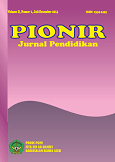INTERNALIZATION STRATEGY OF RABBANI CHARACTER VALUES FOR STUDENT PRIMARY SCHOOL
DOI:
https://doi.org/10.22373/pjp.v12i2.19536Abstract
This article aims to examine strategies for internalizing rabbani character values in the learning process for high-class students at the favorite Madrasah Ibtidaiyah in Lhokseumawe City. This study was born because character education in the millennial education system was developed only in learning/religious themes, even though it was written in the lesson plan that every lesson must contain aspects of character values. Ideally, Islamic education requires humans to have a rabbaniyyun character from an early age. This research is a qualitative research with data collection techniques using interviews, observation, and documentation. The results found in the form of rabbinic character values that were internalized by the teacher to high-class students at the favorite madrasah Ibtidaiyah in the city of Lhokseumawe were faith and obedience to Allah, distinguishing good and bad behavior, trustworthiness, forgiving each other, not taking drugs, not witnessing falsely, thinking and work hard, positive thinking, generous spirit, and help each other in goodness. While the strategies used by teachers to internalize the value of rabbinic character by strengthening the character of students from low grade, giving wise advice, reading and understanding the Qur'an, getting students to practice their knowledge, being grateful, being wise in speaking and attitude.
Keywords: Strategy, teacher, internalization, rabbani characterReferences
Amrah, S. (2018). Karakter Rabbani Sebagai Medium Pembentukan Kecerdasan Spiritual Dalam Proses Pembelajaran (Sebuah Analisis Empiris Pada Sdit Kota Palopo). El- Tarbawi, 11(1), 1–20. https://doi.org/10.20885/tarbawi.vol11.iss1.art1
Dan, I., Karakter, A. N., Kasus, S., Smp, D., Widyaningsih, T. S., Zuchdi, D., & Study, A.
C. (2009). THE INTERNALIZATION AND ACTUALIZATION OF CHARACTER VALUES IN THE STUDENTS OF JUNIOR HIGH SCHOOLS IN PHENOMENOLOGICAL PERSPECTIVE. 181–195.
Development, T. H. E., Character, O. F., Model, E., An, T., Curriculum, I., Elementary, A.
T., … City, M. (2017). IJLRES - International Journal on Language , Research and
Education Studies ISSN : 2580-6777 ( p ); 2580-6785 ( e ) THE DEVELOPMENT OF CHARACTER EDUCATION MODEL TROUGH AN The Development of Character Education Model by Integrated Curriculum at Elementary . 1(2), 298–311.
F, H. M. (2009). Gur Sejati Membangun Insan Berkarakter Kuat dan Cerdas. Surakarta: Yuma Pustaka.
Islami, M. (2016). Character Values and Their Internalization in Teaching and Learning English at Madrasah. Dinamika Ilmu, 16(2), 279. https://doi.org/10.21093/di.v16i2.417
Isnaini, M. (n.d.). ISLAM. 445–450.
Khobir, A. (2009). Pendidikan Agama Islam Di Era Globalisasi. Edukasia Islamika, 7(1),
–11.
Moleong, L. J. (2008). Metode Penelitian Kualitatif (I). Bandung: Remaja Rosdakarya. Nugroho, P. (n.d.). Internalisasi Nilai-Nilai Karakter DAN KEPRIBADIAN MAHASISWA
PENDIDIKAN AGAMA ISLAM MELALUI PENDEKATAN HUMANIS-RELIGIUS.
(2), 355–382.
Penelitian, J., & Tengah, J. (2017). INTERNALISASI NILAI-NILAI AKHLAQUL. 11(1),
–68.
Putra, P., Syafiuddin, S. M., & Barat, K. (2017). Internalisasi Pendidikan Karakter pada Pembelajaran IPA melalui Model Konstruktivisme di Madrasah Ibtidaiyah Negeri Sebebal INFORMASI ARTIKEL. 2(2), 75–88.
Rachmah, E. Y. (2005). Psikologi Perkembangan. Yogyakarta: Teras.
Ramdani, F. M., Hufad, A., & Supriadi, U. (2017). PROGRAM INTERNALISASI NILAI PENDIDIKAN KARAKTER PADA ANAK USIA DINI. 7(2), 386–398.
Shihab, M. Q. (2006). Tafsir al-Misbah; Pesan, Kesan, dan Keserasian al-Qur’an (2nd ed.). Tangerang: Lentera Hati.
Tinggi, S., Islam, A., Islam, U., Raden, N., & Palembang, F. (2017). Implementasi Pendidikan Karakter di Madrasah Ibtidaiyah Rahmat Rifai Lubis Miftahul Husni Nasution A . Pendahuluan Sejak tahun 2010 , pemerintah melalui Kementerian Pendidikan Nasional mencanangkan penerapan pendidikan karakter bagi semua tingkat pendidik. 3, 15–32.
Tsai, K. C. (2012). Bring character1 education into classroom. EuSropean Journal of
Educational Research, 1(2), 163–170. https://doi.org/10.12973/eu-jer.1.2.16
Downloads
Additional Files
Published
Issue
Section
License
- Authors retain copyright and grant the journal right of first publication with the work simultaneously licensed under a Creative Commons Attribution License that allows others to share the work with an acknowledgment of the work's authorship and initial publication in this journal.
- Authors are able to enter into separate, additional contractual arrangements for the non-exclusive distribution of the journal's published version of the work (e.g., post it to an institutional repository or publish it in a book), with an acknowledgment of its initial publication in this journal.
- Authors are permitted and encouraged to post their work online (e.g., in institutional repositories or on their website) prior to and during the submission process, as it can lead to productive exchanges, as well as earlier and greater citation of published work (See The Effect of Open Access).

